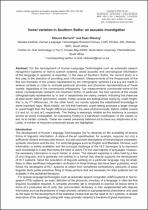JavaScript is disabled for your browser. Some features of this site may not work without it.
- ResearchSpace
- →
- Research Publications/Outputs
- →
- Journal Articles
- →
- View Item
| dc.contributor.author |
Barnard, E

|
|
| dc.contributor.author |
Wissing, D

|
|
| dc.date.accessioned | 2012-01-30T12:57:15Z | |
| dc.date.available | 2012-01-30T12:57:15Z | |
| dc.date.issued | 2008 | |
| dc.identifier.citation | Barnard, E and Wissing, D. 2008. Vowel variation in Southern Sotho: an acoustic investigation. Southern African Linguistics and Applied Language Studies, Vol 26(2), pp 255-265 | en_US |
| dc.identifier.issn | 1607–3614 | |
| dc.identifier.uri | http://www.ajol.info/index.php/salas/article/viewFile/6670/55037 | |
| dc.identifier.uri | http://hdl.handle.net/10204/5545 | |
| dc.description | Copyright: 2008 NISC | en_US |
| dc.description.abstract | For the development of Human Language Technologies such as automatic speech recognition systems or text-to-speech systems, exact acoustic and phonological information of the language in question is essential. In the case of Southern Sotho, the current study is a first step in the direction of providing such information. Measurements of the frequencies of the first two formants of the vowels represented by the orthographic symbols i e a o u are made in several contexts in order to motivate particular phonetic and phonemic representations of these vowels, regardless of the conventional orthography. Our measurements corroborate some of the earlier impressionistic research into Southern Sotho. In particular, the four variants of the vowels orthographically represented by ‘e’ and ‘o’ respectively are clearly present, indicating that there are at least seven distinct (phonemic) vowels. These variants are distinguished mainly by vowel height, that is, by F1 differences. On the other hand, our results oppose the established knowledge in some important ways. Most notably, we find that harmonic vowel raising produces a larger change in vowel height than the height difference between the pairs of phonemically distinct middle vowels (/ / and /o/, /e/ and /e/), respectively. The finding is seemingly reliable as this tendency is constant across all words investigated. An interesting finding is a significant modification of the vowels /u/and /a/ in certain contexts. These are vowels previously believed not to have any allophones at all. Lastly, a number of important unresolved issues are highlighted. | en_US |
| dc.language.iso | en | en_US |
| dc.publisher | NISC | en_US |
| dc.subject | Southern Sotho | en_US |
| dc.subject | Vowel variation | en_US |
| dc.subject | Acoustic information | en_US |
| dc.subject | Phonology | en_US |
| dc.subject | Applied language studies | en_US |
| dc.subject | Southern African linguistics | en_US |
| dc.subject | Human language technologies | en_US |
| dc.title | Vowel variation in Southern Sotho: an acoustic investigation | en_US |
| dc.type | Article | en_US |
| dc.identifier.apacitation | Barnard, E., & Wissing, D. (2008). Vowel variation in Southern Sotho: an acoustic investigation. http://hdl.handle.net/10204/5545 | en_ZA |
| dc.identifier.chicagocitation | Barnard, E, and D Wissing "Vowel variation in Southern Sotho: an acoustic investigation." (2008) http://hdl.handle.net/10204/5545 | en_ZA |
| dc.identifier.vancouvercitation | Barnard E, Wissing D. Vowel variation in Southern Sotho: an acoustic investigation. 2008; http://hdl.handle.net/10204/5545. | en_ZA |
| dc.identifier.ris | TY - Article AU - Barnard, E AU - Wissing, D AB - For the development of Human Language Technologies such as automatic speech recognition systems or text-to-speech systems, exact acoustic and phonological information of the language in question is essential. In the case of Southern Sotho, the current study is a first step in the direction of providing such information. Measurements of the frequencies of the first two formants of the vowels represented by the orthographic symbols i e a o u are made in several contexts in order to motivate particular phonetic and phonemic representations of these vowels, regardless of the conventional orthography. Our measurements corroborate some of the earlier impressionistic research into Southern Sotho. In particular, the four variants of the vowels orthographically represented by ‘e’ and ‘o’ respectively are clearly present, indicating that there are at least seven distinct (phonemic) vowels. These variants are distinguished mainly by vowel height, that is, by F1 differences. On the other hand, our results oppose the established knowledge in some important ways. Most notably, we find that harmonic vowel raising produces a larger change in vowel height than the height difference between the pairs of phonemically distinct middle vowels (/ / and /o/, /e/ and /e/), respectively. The finding is seemingly reliable as this tendency is constant across all words investigated. An interesting finding is a significant modification of the vowels /u/and /a/ in certain contexts. These are vowels previously believed not to have any allophones at all. Lastly, a number of important unresolved issues are highlighted. DA - 2008 DB - ResearchSpace DP - CSIR KW - Southern Sotho KW - Vowel variation KW - Acoustic information KW - Phonology KW - Applied language studies KW - Southern African linguistics KW - Human language technologies LK - https://researchspace.csir.co.za PY - 2008 SM - 1607–3614 T1 - Vowel variation in Southern Sotho: an acoustic investigation TI - Vowel variation in Southern Sotho: an acoustic investigation UR - http://hdl.handle.net/10204/5545 ER - | en_ZA |






